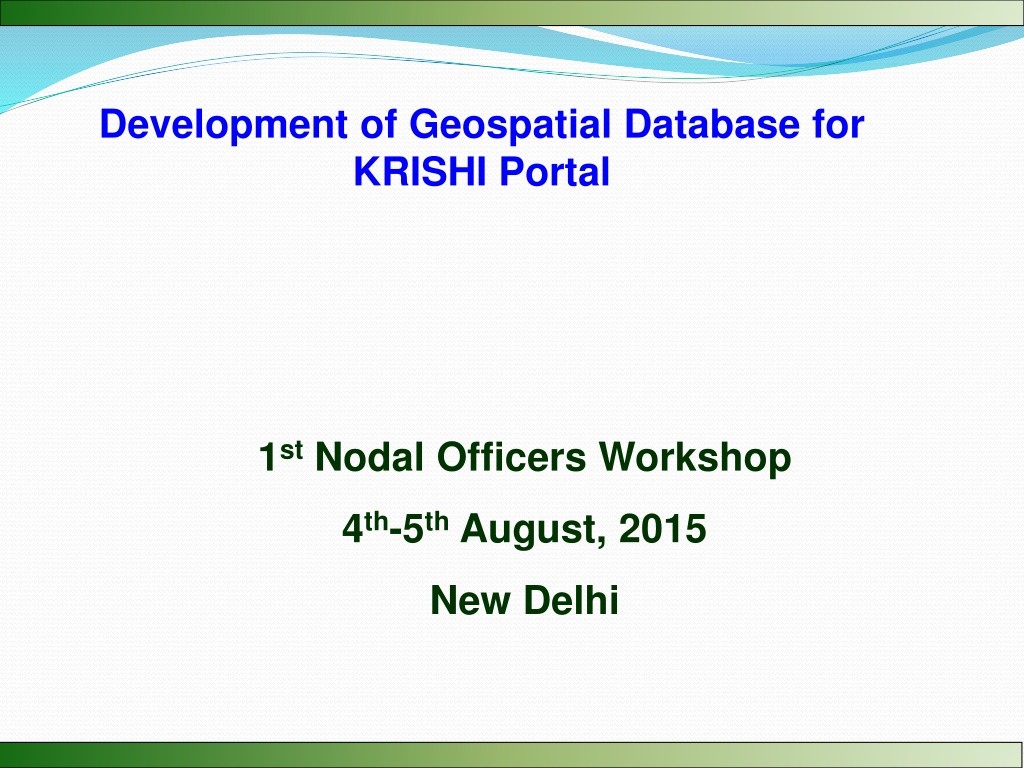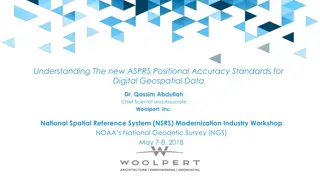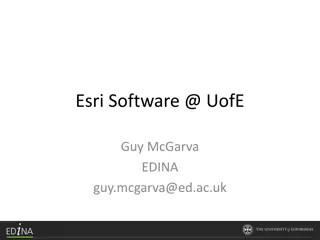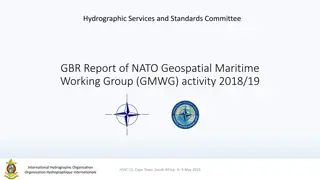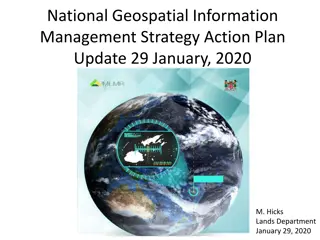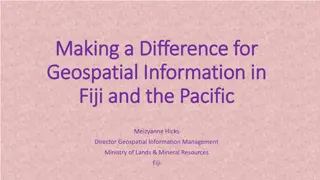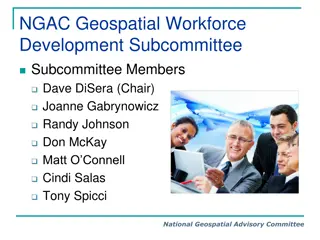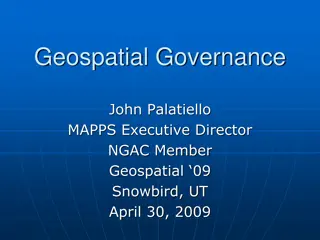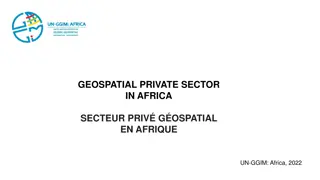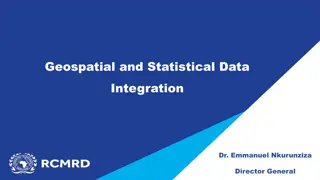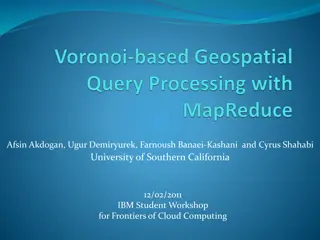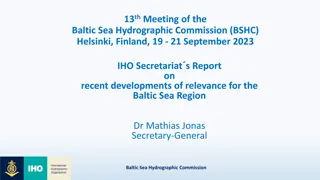Geospatial Database Development for KRISHI Portal: Nodal Officers Workshop
Geospatial databases play a crucial role in providing location-specific agricultural services through the KRISHI Portal. This workshop focuses on the core objective of the portal, simple GeoPortal architecture, main services offered, the significance of geospatial data, and the utilization of spatial and non-spatial data in GIS for effective decision-making in agriculture.
Download Presentation

Please find below an Image/Link to download the presentation.
The content on the website is provided AS IS for your information and personal use only. It may not be sold, licensed, or shared on other websites without obtaining consent from the author. Download presentation by click this link. If you encounter any issues during the download, it is possible that the publisher has removed the file from their server.
E N D
Presentation Transcript
Development of Geospatial Database for KRISHI Portal 1st Nodal Officers Workshop 4th-5th August, 2015 New Delhi
Database Grid Decision Support Knowledge Information Data
CORE OBJECTIVE OF KRISHI PORTAL Is to provide the location specific agri-based services, geographic data along with the metadata in a compatible format of international standards through a common infrastructure. service of
What is simple GeoPortal architecture? Users Data providers control access to their data GIS Web Services Portals Data Servers Publish GIS data and services GeoPortal FTP GIS Data GIS Data The GeoPortal does not store the data GIS Data
What are the main services of GeoPortal Discovery service = CSW (Catalogue Service Web) Viewing service = WMS, WCS (Web Map Service, Web Coverage Service) Download service = WFS (Web Feature Service)
Spatial data Any data which are directly or indirectly referenced to a location on the surface of the earth are spatial data. Non-Spatial data When a dataset cannot usefully be related to a location on the surface of the earth are non-spatial data.
Why we need Geospatial data for KRISHI To explore both geographical and thematic components of data in a holistic way To address geographical aspects of a agricultural research issues To allow handling and exploration of large volumes of spatial datasets To allow integration of data from widely disparate sources To allow a wide variety of forms of visualisation
Data in GIS Spatial and attribute Geo-referencing data Raster and vector Layers of data Querying a GIS database Integrating data with GIS
Coordoning System Coordinate units at DDMMSS (degree, minutes, seconds) Projection System: UTM projection World Geodetic System 1984 (WGS 84)
Layers Data on different themes are stored in separate layers As each layer is geo-referenced layers from different sources can easily be integrated using location This can be used to build up complex models of the real world from widely disparate sources
Raster data Satellite Sensor: Landsat ETM+ Spatial resolution: 30 m.
Querying GIS data Attribute query Select features using attribute data (using SQL) Results can be mapped or presented in conventional database form Can be used to produce maps of subsets of the data or choropleth maps Spatial query Clicking on features on the map to find out their attribute values Used in combination these are a powerful way of exploring spatial patterns in database
Geo-Spatial Data on Soils Soil Resource Database 1:1M Site Soil Morphological Characteristics Physical Characteristics Chemical Characteristics Characteristics
Soil Site Characteristics
Soil Site Characteristics Soil Site Characteristics A Arial Photo Interpretation Topography And Landform type Observation No Photo No Elevation Above MSL Series and/or Local Name Physiographic Unit Toposheet No Soil_Mapping_legend Geology Location Latitude And Longitude Village Tehsil District State Parent Material Alluvium Colluvium Aeolian Granite Gneiss Schist Sandstone Basalt Limestone Glacial Marine Sediments Undifferentiated Weathered Basalt Granite Gneiss Climate Humid Sub-Humid(Moist) Sub-Humid(Dry) Per humid Semi-Arid(Moist) Semi-Arid(dry) Typic-Arid Hyper-Arid Slope Gradient(%) Level to nearly level Very gently sloping Gently sloping Moderately sloping Moderately steep Steeply sloping Very steeply sloping Slope Gradient(m) Rainfall Very-low Low Moderately-low Moderate Moderately-High High Very-high Excessive Author and date of examination Erosion None to very slight Slight Moderate Severe Very Severe Suitability Class Suitable Moderately Suitable Marginally Suitable Actually unsuitable but potentially suitable Actually & potentially unsuitable Important Crops Cereals Oilseeds Cash Crops Management Practices Low Medium High
Soil Site Characteristics Soil Site Characteristics Observation No, Observation No, Toposheet S.No Data Element Name Toposheet No, Photo No, Author and Date of Examination No, Photo No, Author and Date of Examination Short Name Type Measure mum value Value Observation_No Chara- cter Data Unit Of Description Mini- Maxi- mum 1 Follow codification as indicated below (district symbol followed by block, village and profile number). 2 Toposheet_No Chara- cter A toposheet is a shortened name for topographic sheet. They are essentially contain information about an area like roads, railways, settlements, canals, rivers, electric poles, post offices etc. 3 Photo_No Chara- cter The number assigned to the photo, where the photo was captured at the profile site. Give the name of the Officer in-charge of the field party and date of observation. 4 Charact er Author_And_Date _Of_Examination 5 Location details Chara- cter Indicate the exact location of the profile on the cadastral map within the survey number and describe the location of the profile with reference to some nearby fixed features.
Drainage Unit Of Measure Mini- mum value Maxi- mum Value 21 Drainage d Character Natural drainage class refers to the frequency and duration of wet periods under conditions similar to those under which the soil developed. Alteration of the water regime, either through drainage or irrigation, is not a consideration unless the alterations have significantly changed the morphology of the soil. Similar to poorly drained soils except that the soils occur on level or depressed areas and are frequently ponded. Thick organic (0) horizons are common Water is removed so slowly that the soil is wet at shallow depths , sometimes for long periods . Water table is persistently shallow, such that most crops cannot be grown unless the soil is artificially drained . The soil is wet at a shallow depth for significant periods during the growing season. Wetness restricts the growth of crops unless artificial drainage is provided. The soils commonly have a pervious layer, a high water table , additional water from seepage and/or nearly continuous rainfall. Water is removed from the soil somewhat slowly. Soil is wet for only a short time within the rooting zone during the growing season , but long enough that most mesophytic crops are affected . These soils commonly have a slowly pervious layer within the upper one metre, periodically receive high rainfall, or both Water is removed from the soil readily but not rapidly . Water is available to plants throughout most of the growing season. Wetness does not inhibit growth of roots for most or all of the growing season. Similar to excessively drained soils, but the water table may not be as deep and the soil may be slightly fine textured Water is removed from the soil very rapidly . Soil is commonly very coarse textured or rocky Very poor Character poor Character Imperfectly drained Character Moderately well Character Well Character Somewhat Excessive Excessive Character Character
Soil Morphological Characteristics
SOIL MORPHOLOGICAL CHARACTERISTICS SOIL MORPHOLOGICAL CHARACTERISTICS A Horizon Organic Material Mineral Horizon Mineral Horizon Mineral Horizon Mineral Horizon Bed Rock Depth Very Deep Very Shallow Shallow Moderately Shallow Moderately deep Deep Extremely Shallow Boundary Distinctness abrupt clear gradual diffuse T-Topography smooth wavy irregular Broken Mottle Color (Munsell) Consistence D-Dry loose soft slightly hard hard very hard extremely hard M-Moist loose very friable friable firm -very firm extremely firm W-Wet non sticky slightly sticky sticky very sticky non plastic slightly plastic plastic very plastic Structure S-Size very fine fine medium -coarse very coarse G-Grade Structure less weak moderate strong Type granular crumb columnar prismatic platy angular blocky sub angular block single grain massive A-Abundance few common many S-Size fine medium coarse C-Contrast faint distinct prominant Texture( USDA) sand loamy fine sand loamy sand sandy loam loam silty loam silt sandy clay loam clay loam silty clay loam sandy clay silty clay clay Cutans Ty-Type Argiilan farran Mangan Organ Th-Thickness thin moderately thick thick Q-Quantity patchy broken continuous
Coarse fragments This refers to the presence of coarse fragments (>2 mm in size) on or near the soil surface. The classes used are pebbles, cobbles, stones and boulders. Gravel is a collection of pebbles that have diameters ranging from 2 to 75 mm. The size of the cobbles range from 23 75 to 250 mm (3 to 10 inches), stones from 250 to 600 mm (10 to 24 inches) and boulders above 600 mm (>24 inches). Assessment for the surface fragments is done separately for the gravel and for stones and boulders. Indicate the size of the fragments observed in the field. The coarse fragments that have diameters less than 2.5 cm Coarse_ fragments Chara- cter Percent 8 fine gravel fg Character <2.5 coarse gravel cg Character 2.5 7.5 The coarse fragments that have diameters ranging from 2.5 to 7.5 cm. stone st Character 7.5 25 The coarse fragments that have diameters ranging from 7.5 to 25 cm.
Soil Physical Characteristics
SOIL PHYSICAL CHARACTERISTICS SOIL PHYSICAL CHARACTERISTICS Bulk Density Saturated Hydraulic Conductivity Horizon Organic Material Mineral Horizon Mineral Horizon Mineral Horizon Mineral Horizon Bed Rock Depth Very Deep Very Shallow Shallow Moderately Shallow Moderately deep Deep Extremely Shallow Particle size Class Fragmental Sandy skeletal Loamy skeletal Clayey Skeletal Sandy Very Fine Coarse loamy Fine Loamy Coarse silty Silty Clayey Fine Loamy Moisture Retention Texture(USDA) Sand loamy fine sand loamy sand sandy loam loam silty loam silt sandy clay loam clay loam silty clay loam sandy clay silty clay clay Available Water Capacity Water Holding Capacity
Soil Depth 2 Depth D Integer cm Soil depth indicates the depth of the solum, which includes A and B horizons, occurring above the parent material or hard rock. Depth is measured from the soil surface. Soil depth ranging from 0 to 10 cm Extremely Shallow Integer cm 0 10 Very Shallow Shallow Integer cm 10 25 Soil depth ranging from 10 to 25 cm Soil depth ranging from 25 to 50 cm Soil depth ranging from 50 to 75 cm Integer cm 25 50 Moderately Shallow Integer cm 50 75 Moderately deep Deep Integer cm 75 100 Soil depth ranging from 75to 100 cm Soil depth ranging from 100 to 150 cm Soil depth > 150 cm Integer cm 100 150 Very Deep Integer cm >150
Soil Chemical Characteristics
SOIL CHEMICAL CHARACTERISTICS SOIL CHEMICAL CHARACTERISTICS Soil reaction (pH) Strongly acidic Moderately acidic Slightly acidic Neutral Slightly alkaline Moderately alkaline Strongly alkaline Salinity Negligible Slight Moderate Moderately Strong Strong Severe Sodicity Negligible Slight Strong Severe Depth Very Deep Very Shallow Shallow Moderately Shallow Moderately deep Deep Extremely Shallow Horizon Organic Material Mineral Horizon Mineral Horizon Mineral Horizon Mineral Horizon Bed Rock Calcium Carbonate Electrical_Conductivity Very Severe Extractable_Nutrients Nitrogen Phosporous Potassium Sulphur Calcium Magnesium Boron Manganese Zinc Iron Copper Cation Exchange Capacity Calcium Magnisium Sodium Potassium Aluminium Hydrogen Extractable Cations Calcium Magnisium Sodium Potassium Base saturation Percent Exchangeable Sodium Percentage Sum Of Cations Organic Carbon
Soil Reaction(pH) 3 Soil reaction (pH) pH Float ----- 0 14 Both electrometric methods are used for measuring pH. It is the negative logarithm of hydrogen iron concentration. pH ranges from 4 to 4.5 pH ranges from 4.5 to 5.5 colorimetric and Strongly acidic Moderately acidic Slightly acidic Neutral Slightly alkaline Moderately alkaline Strongly alkaline Float Float 4 4.5 5.5 4.5 Float Float Float Float 5.5 6.5 7.5 8.5 6.5 7.5 8.5 9.5 pH ranges from 5.5 to 6.5 pH ranges from 6.5 to 7.5 pH ranges from 7.5 to 8.5 pH ranges from 8.5 to 9.5 Float >9.5 pH is greater than 9.5
Metadata Development
Metadata Metadata is usually described as data about the data. It is the information you need to document your dataset sufficiently so that an outsider can understand all the key issues involved in the construction of the dataset.
Roles/purposes of Metadata Information retrieval, cataloguing, querying and searching for data electronically. Describing fitness for use (applicability) and documenting the usability and quality of data. Describing how to transfer, access or process data Documenting all relevant characteristics of data needed to use it Data permanence; creates institutional memory;
Why use and create metadata To organize and maintain spatial data Metadata can catalogue the changes and updates made to each spatial dataset To provide information to the users It makes sense to share existing data sets rather than producing new ones if they are already available To document the history of a spatial data set Metadata documents what changes have been made to each dataset, such as changes in geographic projection, adding or deleting attributes, editing line changing file formats. intersections, or
Metadata Should Include Date of data collected Date of coverage generated Bounding coordinates From where original data came Who did processing Projection coordinate System Datum Units Spatial scale Attribute definitions Who to contact for more information
Documentation and Metadata Critical components usually break down into: 1. Dataset identification, overview 2. Data quality 3. Spatial reference information 4. Data definition 5. Administrative information (distribution)
Documentation and Metadata 1. Data identification General info: name and brief ID of dataset and owner geographic domain, general description/ summary of content, data model used to represent spatial features, intent of production, language used constraints on access and use organization,
2. Data quality should address: Positional accuracy Attribute accuracy Logical consistency Completeness Lineage Processing steps
3. Spatial reference should include: Coordinate system (e.g. UTM projection) Includes projection details like, latitudes and longitude extends, projection origin, projection zone etc,. Geodetic model (WGS 84)
4. Data definition, also known as Entity and Attribute Information, should include: Entity types (e.g. point, polygon, raster) Information about including label, definition, domain of values Sometimes will include a data dictionary, or description of attribute codes, while sometimes it will reference a document with those codes if they are too long and complex each attribute,
5. Data distribution info usually includes: Name, address, phone, email of contact person and organization Liability information Ordering information, including online and ordering by other media; usually includes fees
Metadata Format Metadata Format
KRISHI GeoPortal Architecture Outputs User Interface Spatial database Shell and GUI KRISHI Geoportal Attribute database Attribute database Meta database Geometrical database Raster database
